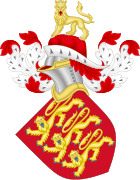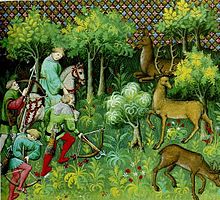Charter of the Forest
 From Wikipedia - Reading time: 10 min
From Wikipedia - Reading time: 10 min
| Act of Parliament | |
 | |
| Long title | Carta de Foresta |
|---|---|
| Citation | 25 Edw. 1 |
| Dates | |
| Royal assent | 1297 |
| Other legislation | |
| Amended by | Criminal Statutes Repeal Act 1827, Criminal Statutes (Ireland) Repeal Act 1828, Criminal Law (India) Act 1828 |
| Repealed by | Wild Creatures and Forest Laws Act 1971 |
| Relates to | Magna Carta (1297), Confirmation of the Charters (1297), A Statute Concerning Tallage (1297) |
Status: Repealed | |
| Text of the A Statute Concerning Tallage (1297) as in force today (including any amendments) within the United Kingdom, from legislation.gov.uk. | |

The Charter of the Forest of 1217[1] re-established rights of access for free men to the royal forest that had been eroded by King William the Conqueror and his heirs. Many of its provisions were in force for centuries afterwards.[2] It was originally sealed in England by the young King Henry III, acting under the regency of William Marshal, 1st Earl of Pembroke.[3]
It was in many ways a companion document to the Magna Carta.[4] The charter redressed some applications of the Anglo-Norman Forest Law that had been extended and abused by King William Rufus.
History
[edit]"Forest"[5] to the Normans meant an enclosed area where the monarch, or sometimes another aristocrat, had exclusive rights to animals of the chase and the greenery ("vert") on which they fed.[6] It did not consist only of trees but included large areas of commons such as heathland, grassland, and wetlands, productive of food, grazing, and other resources.[7]
Lands became more restricted as King Richard and King John designated increasing areas as royal forest, off-limits to commoners. At its widest extent, royal forest covered about one-third of the land of southern England.[6] Thus, it became an increasing hardship for the common people to try to farm, forage, and otherwise use the land they lived on.[citation needed]
The Charter of the Forest was first issued on 6 November 1217 at Old St Paul's Cathedral, London[8] as a complementary charter to the Magna Carta from which it had evolved. It was reissued in 1225[9] with several minor changes to wording, but cancelled in 1227 when Henry III declared his adulthood. It was joined with the Magna Carta in the Confirmation of Charters in 1297.[10]
At a time when royal forests were the most important potential source of fuel for cooking, heating, and industries such as charcoal burning, and of such hotly defended rights as pannage (pasture for their pigs), estover (collecting firewood), agistment (grazing), or turbary (cutting of turf for fuel),[11][page needed] this charter was almost unique in providing a degree of economic protection for free men who used the forest to forage for food and to graze their animals.[12]
In contrast to the Magna Carta, which dealt with the rights of barons, it restored to the commoner some fundamental rights, privileges, and protections against the abuses of an encroaching aristocracy.[13] For many years it was regarded as a development of great significance in England's constitutional history, with the great seventeenth-century jurist Sir Edward Coke referring to it along with Magna Carta as the Charters of England's Liberties,[6] and Sir William Blackstone remarking in the eighteenth century that:
There is no transaction in the antient part of our English history more interesting and important, than … the charters of liberties, emphatically stiled THE GREAT CHARTER and CHARTER OF THE FOREST …[14]
Contents
[edit]
The first chapter of the charter protected common pasture in the forest for all those "accustomed to it", and chapter nine provided for "every man to agist his wood in the forest as he wishes".[6] It added "Henceforth every freeman, in his wood or on his land that he has in the forest, may with impunity make a mill, fish-preserve, pond, marl-pit, ditch, or arable in cultivated land outside coverts, provided that no injury is thereby given to any neighbour." The charter restored the area classified as "forest" to that of Henry II's time.[citation needed]
Clause 10 repealed the death penalty (and mutilation as a lesser punishment) for capturing deer (venison), though transgressors were still subject to fines or imprisonment.[15] Special verderers' courts were set up within the forests to enforce the laws of the charter.[citation needed]
Development
[edit]By Tudor times, most of the laws served mainly to protect the timber in royal forests. Some clauses in the Laws of Forests remained in force until the 1970s. The special courts still exist in the New Forest and the Forest of Dean. In this respect, the charter was the statute that remained longest in force in England from 1217 until superseded by the Wild Creatures and Forest Laws Act 1971.[16]
The charter was a vehicle for asserting the values of the commons and the right of commoners against the state and the forces of commodification.[17] The Act that replaced it was about the protection of nature and administering the commodification of natural resources.[16]
To mark 800 years of the Charter of the Forest, in 2017, the Woodland Trust and more than 50 other cross-sector organisations joined forces to create and launch a Charter for Trees, Woods and People, reflecting the modern relationship with trees and woods in the landscape for people in the UK.[18]
Significance
[edit]According to Guy Standing, the charter "was not about the rights of the poor, but about the rights of the free. For its time and place, it was a radical assertion of the universality of freedom, its commonality."[4]
Surviving copies
[edit]It is claimed that only two copies of the 1217 Charter of the Forest survive, belonging to Durham Cathedral and Lincoln Cathedral. The Lincoln copy is usually on display in the David P J Ross Magna Carta Vault in Lincoln Castle, together with the Lincoln copy of the Magna Carta. A manuscript of the 1225 reissue narrowly escaped destruction in 1865 and is now available in the British Library (Add. Ch. 24712).[19]
A recently discovered copy of the 1300 edition of the Charter of the Forest is in Sandwich Guildhall Museum in Kent.[20]
In popular culture
[edit]The charter has inspired the name of the Read-Opera The Charter of the Forest, which deals with themes such as free people's relation to power, which were codified in one form by the original Charter of the Forest.[21]
See also
[edit]- English land law
- Forestry in the United Kingdom
- R v Hampden (1637) 3 Howell State Trials 825, known also as the Case of Shipmony, leading to the Ship Money Act 1640
Notes
[edit]- ^ (Latin: Carta de Foresta or Charta Forestæ)
- ^ Henry III's Charter of the Forest: facsimile and translation
- ^ "William Marshal earl of Pembroke, ruler of us and of our kingdom" is mentioned by name.
- ^ a b Standing, Guy (29 August 2019). Plunder of the Commons: A Manifesto for Sharing Public Wealth. Penguin UK. p. 25. ISBN 978-0-241-39633-9. OCLC 1083358125.
- ^ A term derived from the Latin "foris", a door or gate.
- ^ a b c d Geraldine van Buren, "Take Back Control: A new Commons Charter for the twenty-first century is overdue, 800 years after the first": in Times Literary Supplement, 10 March 2017, pp. 23–25.
- ^ "The alternatives to privatisation and nationalisation". The Economist. 12 September 2019. ISSN 0013-0613. Retrieved 10 November 2019.
- ^ Rothwell, Harry English Historical Documents 1189–1327 (1995) p. 337
- ^ Rothwell, Harry English Historical Documents 1189–1327 (1995) p. 347
- ^ Rothwell, Harry English Historical Documents 1189–1327 (1995) p. 485
- ^ George C. Homans, English Villagers of the Thirteenth Century, 1941.
- ^ "Forests and Chases: Henry III's Charter of the Forest". St John's College Oxford. Retrieved 7 May 2010.
- ^ "Forests and Chases: Henry III's Charter of the Forest". St John's College Oxford. Retrieved 7 May 2010.
- ^ William Blackstone, Tracts, chiefly relating to the antiquities and laws of England. Oxford. 30 November 1771. hdl:2027/njp.32101073365205. Retrieved 7 August 2018. (Oxford 1771) p. 283.
- ^ cl 10 read, "No one shall henceforth lose life or limb because of our venison, but if anyone has been arrested and convicted of taking venison he shall be fined heavily if he has the means; and if he has not the means, he shall lie in our prison for a year and a day ..."
- ^ a b Standing, Guy (2019). Plunder of the Commons. National Geographic Books. p. 23. ISBN 9780141990620.
- ^ Standing, Guy (2019). Plunder of the Commons. National Geographic Books. pp. 1–23. ISBN 9780141990620.
- ^ "The Charter for Trees, Woods and People". Retrieved 25 July 2017.
- ^ Harrison, Julian. "How The Forest Charter Was Saved From Destruction". Medieval manuscripts blog. Retrieved 12 July 2017.
- ^ Press Association (8 February 2015). "£10m Magna Carta found in council archives. Expert says the discovery of 1300 edition of the historic document raises hopes that there are more than the 24 copies currently known about in existence". The Guardian.
- ^ "The Charter of the Forest". The Charter of the Forest. Archived from the original on 23 February 2020. Retrieved 10 January 2020.
References
[edit]- GC Homans, English Villagers of the Thirteenth Century (1941)
- H Rothwell, English Historical Documents 1189–1327 (1995)
- P. Linebaugh, The Magna Charta Manifesto (2008)
External links
[edit]- BBC Radio 4 "The Things We Forgot to Remember," Series 2 Episode 4, from 6:15 onwards
- "The Great Charter and Charter of the Forest". British Library. Retrieved 9 May 2022.
- Green, Jeffrey Edward (2010). "The Magna Carta Manifesto (Review)". Insight Turkey. 12 (2).
- "The Charter of the Forest of King Henry III". St John's College, Oxford. Retrieved 9 May 2020.
- Harris, Carolyn (17 December 2013). "Charter of the Forest". Magna Carta Canada. Archived from the original on 6 November 2020.
- The Woodland Trust (2017). "Charter for Trees, Woods and People".
- Lincoln Castle Magna Carta (and Charter of the Forest) display page
 KSF
KSF